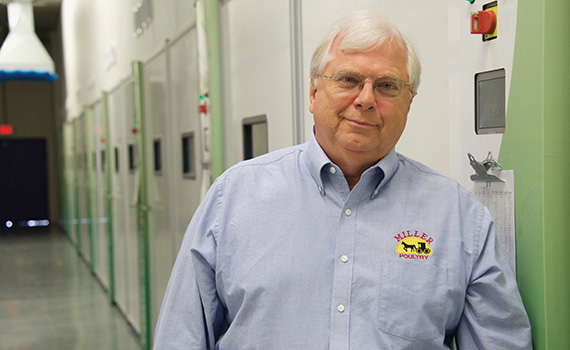Successful ABF production: Mastered technique or corporate culture?
Galen Miller seemed uneasy about being interviewed. The owner and president of Miller Poultry is a warm, affable guy who’s happy to talk politics, music, food and social trends. But when Poultry Health Today wanted to learn more about his company’s 15 years’ experience raising broilers without antibiotics, he suddenly became tight-lipped — and probably for good reason.
Broiler production is a highly competitive industry so, understandably, Miller wasn’t about to share all his secrets about feed ingredients, water treatments, litter management, brooding, temperature, ventilation or stocking rates.
But after spending a few hours with Miller and his energetic director of live operations, Stephen Shepard, it became clear the company’s success with antibiotic-free (ABF) production wasn’t just rooted in technical know-how.
‘Interesting point’
Asked if Miller Poultry’s rapid growth — 30% over the past year — and command of ABF production might have as much to do with its corporate culture, Miller paused and said candidly, “That’s an interesting point and I’m not sure we’ve ever separated the two.”
He then added, “Antibiotic-free production is costly and comes with a lot of challenges. It takes time to perfect. To make it work, I think it is more about your people, as well as the quality and the integrity of the process.
“It takes a lot of energy and sometimes you ask if it’s worth it,” he continued, “but then it comes back to the whole integrity discussion, you know? So yes, I think our approach to the business is a big part of it.” And by today’s commercial standards, it is a unique approach.
Brutal winters
Miller Poultry is based in Orland, Indiana, minutes from the Michigan border, 150 miles east of Chicago and some 650 miles north of the broiler-dense regions of Georgia, Alabama, Mississippi and Arkansas. That long distance from other broiler farms is a big plus for biosecurity, Shepard said, but Midwestern winters can be brutal with heavy snow, subzero windchills and relentless disease pressure. “Winter ventilation, transition ventilation, litter moisture — it’s always a big challenge for us,” he added.
With the help of more than 130 growers in Indiana and Michigan, Miller Poultry now places some 700,000 broiler chicks a week. Most of its growers are Amish and have only one broiler building per farm, each averaging fewer than 30,000 birds. There’s one farm in the company’s network with only 4,000 birds that are actually fed by hand. Of the 700,000 birds in the Miller system, 140,000 are not only antibiotic-free, they’re also certified organic.
“I guess to some people, our setup is kind of like the old days of production — and that has become part of our brand’s story,” Miller said. “But we originally took this approach from a cost standpoint. Antibiotic-free production was new and we didn’t want people to take on a lot of risk or debt. We also thought that limiting the size of each farm was a good way to go from a biosecurity standpoint, which in turn minimized the disease threat and financial risk.”
3.6% mortality
Their one-barn-per-farm approach appears to be working. Shepard reported that Miller Poultry’s average flock morality over the past 12 months has been 3.6%, which rivals much larger producers using antibiotics. More significantly, from a welfare standpoint, it’s less than half what is typically seen in ABF production systems.
As soon as those impressive numbers left his lips, however, Shepard quickly caught himself and insisted that they didn’t measure their company’s success by the monthly Agri Stats report.
“That’s not who we are; that’s not what we use as a guide,” Shepard said. “For us, it’s about treating people as you want to be treated. It’s sometimes hard for people in the poultry industry to make that jump when they first come here, but that’s our culture. That’s not to say our way is better than anyone else’s, but that’s what works for us and our customers.”
Screening growers
As with most modern poultry operations, the Miller Poultry’s growers supply the buildings and the labor. The company furnishes the birds, feed and technical expertise. The difference is in the way the growers are compensated.
Miller shuns what he calls “tournament” types of programs, where grower earnings are tied to their performance against other growers in the network. Instead, the company pays each grower based on pre-determined feed conversion and other performance factors.
“We don’t try to beat up our growers over cost and performance,” Miller said. “Everything has its place and everything needs to be respected, whether it’s the birds, the process, the growers, the environment, the customer, the employee.”
To make its ABF programs work, Miller Poultry also contracts exclusively with hands-on owner managers, who are “screened pretty heavily,” Shepard said. Unless it’s the sole owner and his family taking care of the birds, the company shies away from it.
Ironically, Shepard said, they’ve had particularly good success raising ABF birds with former dairy farmers. “I think dairy is one of the hardest, most difficult forms of agriculture,” he explained. “It requires a high level of commitment and management. Growing chickens without antibiotics seems like a breeze for these guys.”
Production audits from retailers, which review everything from feed ingredients to mortality rates to litter quality, also keep Miller Poultry and its growers on their toes. “Some of our folks think these audits are pretty extreme, but honestly, they’ve made us even better at what we do,” Shepard said.
Finding equilibrium
Miller acknowledged that with large-scale ABF production, there sometimes could be a tug of war between the company’s desire to avoid medications and doing what’s best for the birds.
“There’s a constant struggle between those two [areas]. If you put a lot of energy into it, obtaining good health and welfare is achievable without antibiotics, but often at a significant cost that, frankly, a lot of buyers aren’t willing to pay for,” he said.
“Look at cage-free eggs, for example. People say they want them but they’re not willing to pay the premium and now supply exceeds demand, so there’s a lot of instability in that market right now. It needs to find equilibrium. I think we have that with chicken meat production — there’s a certain market that’s willing to pay for it, but conventional still accounts for most of the production.”
For the same reason, Miller thinks that despite the rapid growth of ABF production over the past 5 years, most of the US poultry industry will stick with so-called conventional production techniques, which involves the judicious use of all FDA-approved antibiotics.
No middle ground

The bulk of Miller Poultry’s chicken is sold directly to retailers under its flagship brand, Miller Amish Country Poultry, which includes birds raised without antibiotics as well as a certified organic line.“When a company goes to the extent to put their own name on the product, it adds a whole different element. It becomes personal, real personal,” Miller says on the company website.Toward that end, his goal is to sell mostly to the retail grocery markets in the Midwest and build customer loyalty.
Still, word gets around and in recent years demand for Miller Poultry’s products spread to other regions. Where they once sold to retailers in a 150-mile radius, Miller Poultry’s chicken can now be found in stores from New York City to New Mexico under the brands Pine Manor Farms, Crystal Valley and Katie’s Best, as well as Miller Amish Country Poultry.
Half of Miller Poultry’s production is now air-chilled, a more expensive process than water chilling that proponents say results in more tender, flavorful meat and a crispier skin when cooked.
As of July 2016, Miller added, all birds are raised on non-GMO diets.
While some food retailers have sought middle ground with policies that only forbid antibiotics deemed medically important to humans, Miller doubts those efforts will gain much traction. “Consumers simply don’t understand the differences between antibiotics,” he said. “Sooner or later, it’s going to be all or none.”
While ABF production often works well for smaller, niche marketers such as Miller Poultry, it’s probably not realistic or even practical to think that the US poultry industry could stop using antibiotics in the 9 billion broilers it produces each year.
“Birds eventually get sick and need to be treated,” Miller said. And just as many consumers are not willing to pay a premium for poultry raised without antibiotics, many poultry companies are not structured to raise birds in this manner.
‘Quick, informed decisions’
“With ABF, you also have to be able to make quick and informed decisions; otherwise you jeopardize flock health;” Shepard explained.
“If we have a health problem, I can go directly to Galen and say, ‘I talked with our vet or nutritionist and this is what I think we need to do. You okay with it?’ Not every company works that way. A few larger companies have been successful with ABF, but many are really struggling with it because there are more people to go to, more people who need to sign off.”
Miller Poultry’ consulting veterinarian, Armando Mirande, DVM, says he “agrees 1,000%” that a streamlined decision-making process is essential for a successful ABF program. “As a vet, that’s one of the things that I find very rewarding at Miller — you don’t need to go through three or five layers of management for approval on the selection of a product, the dose, the purchase of the product, the trial we want to run or even the interpretation of results. It’s between one or two people so more gets done and its gets done more quickly.”
Planning for success — and failure
Despite Miller Poultry’s best efforts, Shepard recognizes that after almost 2 years on the job, the day could come when they’ll have no choice but to treat sick birds with an antibiotic and divert them down another channel of production.
In the meantime, he likes chanting a mantra he learned from his good friend and mentor, Mark Burleson, DVM, at Wayne Farms, who told him that “95% of disease issues are helped by poor management” on the farm.
“I strongly believe that to be true and I’ve taken that to heart,” Shepard said. “It goes back to having really high-quality growers and people that spend a lot of time in their barns.”
Is ABF sustainable? Yes, if ‘managed properly’
Back in 2014, when Stephen Shepard was a poultry specialist for Farm Animal Care Training and Auditing and worked with poultry companies transitioning to ABF production, he expressed concern in a Poultry Health Today article that “if not managed properly,” raising poultry without antibiotics was not sustainable.
He cited higher feed costs, higher feed conversions and ABF’s inherent risk to flock welfare and food safety.
Has his position changed since going to work for Miller Poultry 2 years ago? “I don’t think my perspective has changed at all,” he said. “What’s changed is the number of useful tools — products like the E. coli vaccine, for example — that have made it easier and actually reduced some of the bacteria coming into the plant.
“So, I still would stand by the phrase ‘if not managed properly.’ That’s the key.
“If you don’t manage it properly or be proactive, ABF will cause more issues in the field, more mortality. ABF is not for everybody.”
See related article:
5 ABF health tips from Miller Poultry
E. coli infection: Two types in broilers
Posted on September 29, 2017


















